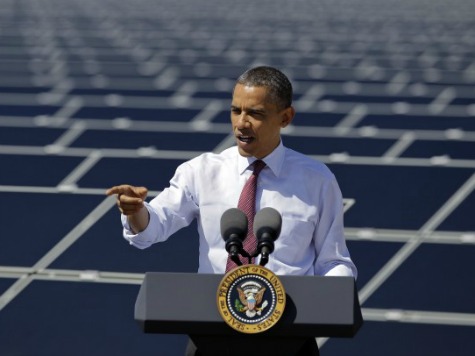On Thursday, the Associated Press reports, “President Barack Obama is ordering the federal government to nearly triple its use of renewable sources for electricity by 2020.”
In October, the Department of Energy announced $60 million in subsidies for solar energy research and development programs as part of the SunShot Initiative. The primary goals of the program are to reduce the cost of photovoltaic solar energy systems by 75 percent and to double the generation of clean energy in the U.S. over the next 25 years–goals that are probably unachievable.
These announcements come on the heels of the recent bankruptcy of the government-subsidized electric vehicle technology company ECOtality, which received $115 million in federal stimulus grants. Of course, that followed the multimillion dollar failures of solar energy companies Solyndra ($529 million) and Abound Solar ($70 million). With last week’s bankruptcy filing by government-backed hybrid car manufacturer Fisker Automotive, a failure which will cost taxpayers $139 million, the question must be asked: Why is the federal government funneling good taxpayer money to bad companies and failing technologies?
The answer may be that cronyism and influence often decide where these loans and subsidies go. In a new study published this week by Reason Foundation, we examined the loan guarantees made by the Department of Energy (DOE) under its “Section 1705” program from 2009 to 2011, which were part of the America Recovery and Reinvestment Act. We looked at lobbying expenditures by recipient companies and correlated them with the size of loan guarantees received. We found a correlation suggesting that the DOE made choices on the basis of the information that was most cognitively available – information provided by lobbyists – rather than on the basis of the viability of the technology and the soundness of the company applying for the subsidies.
In some cases we found evidence of even more direct forms of cronyism. For instance, during his tenure as governor of Maine, now U.S. Senator Angus King signed into law a bill requiring utilities to generate at least 30 percent of their electricity from “green” sources such as wind. After leaving the governor’s office, he founded a wind-energy company, Independence Wind, whose first project, Record Hill Wind, received a $102 million loan guarantee from the Department of Energy — and King received a $407,000 “success” fee. The loan guarantee almost looks like a pat on the back from the DOE for King’s efforts in promoting their agenda while he was governor of Maine.
The worst part is that these crony subsidies and loan guarantees aren’t even going to particularly sound companies or innovative forms of technology. Twenty-two out of the 26 projects funded through the Section 1705 program were rated “junk” level investments. Yet, they were given millions in taxpayer dollars. To date, only four of the projects have been completed and three of the companies receiving Section 1705 loan guarantees have already gone bankrupt. Several other recipients, including SoloPower and the Spanish company Abengoa Solar, are in the process of laying off workers, selling off equipment, and are not paying contractors for services provided.
The DOE’s lack of skin in the game means that they have less incentive to ensure that the money they spend is wisely invested in the best technologies, and in the best companies. It’s much easier to lobby or hoodwink the government into investing in a bad company because unlike a venture capital firm, the money they’re playing with isn’t their own– it’s yours.
Since 1973, U.S. government agencies have spent $154.7 billion on “renewable energy” with very little to show for it. Proponents of solar technology claim that their favored technology is on the verge of being competitive with traditional forms of energy, but they have made the same claim since at least the mid-1990s. Billions of dollars in subsidies later, solar still only comprises at most 0.2 percent of U.S. electricity production according to the Energy Information Administration.
“Green” energy subsidies benefit the politically connected while harming future generations as hundreds of millions of dollars are added to the country’s debt burden with each green failure. It’s time to end all subsidies–for all energy companies, not just green ones–and let the best technologies win.

COMMENTS
Please let us know if you're having issues with commenting.